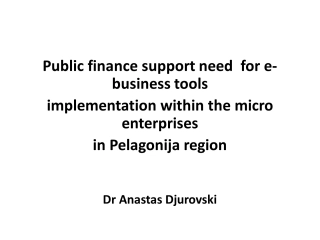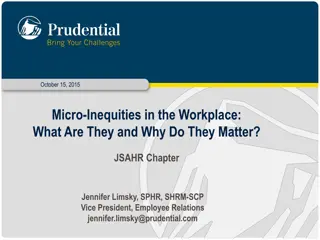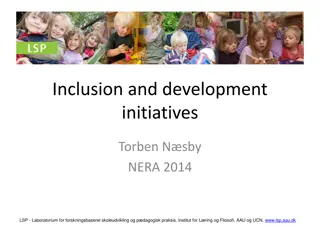Enhancing Financial Inclusion for Street Vendors and Micro Enterprises
Financial inclusion is crucial for street vendors and micro enterprises, with challenges like lack of KYC documents, financial literacy, and accessibility. Prospective solutions involve developing saving habits, financial literacy, and innovative lending processes. Initiatives like MUDRA, DRI Scheme, and PMJJY aim to provide support and security for street vendors. Collaborative efforts from the government, banks, and stakeholders can bridge the gap and empower these vulnerable groups.
Download Presentation

Please find below an Image/Link to download the presentation.
The content on the website is provided AS IS for your information and personal use only. It may not be sold, licensed, or shared on other websites without obtaining consent from the author.If you encounter any issues during the download, it is possible that the publisher has removed the file from their server.
You are allowed to download the files provided on this website for personal or commercial use, subject to the condition that they are used lawfully. All files are the property of their respective owners.
The content on the website is provided AS IS for your information and personal use only. It may not be sold, licensed, or shared on other websites without obtaining consent from the author.
E N D
Presentation Transcript
Financial Inclusion of street vendors Promotion of Micro Enterprises State Bank Of India
Financial Inclusion Stated as Financially including persons from all strata into the mainstream banking system . Financial inclusion index was launched in 2018 based on four dimensions branch penetration, deposit penetration, credit penetration and insurance penetration. The index will have three measurement dimensions; (i) Access to financial services (ii) Usage of financial services and (iii) Quality. The Digital India initiative, payments banks and small finance banks are playing a pivot role along with banks in bridging the financial gap
Finance to Street Vendors Mostly rely on personal savings to invest in their personal, social and professional areas Work on turnover basis and often avail recourse to high interest loans from non-institutional lenders High repayment capacity but absence of Collateral and firm domiciliary status restrict institutional credit
Challenges associated with Financial Inclusion of Street Vendors Lack of KYC documents Lack of Financial literacy Lack of financial accessibility Lack of regular Substantial income (Uncertainty) Low level of savings Unable to provide security against Credit
Prospective Solutions For Vendors: For Government: For Banks: Development of saving habit Financial literacy Basic accounting of receivables and sales Provide legal status by issuing license and providing hawking zones Include vendors in City and Town plans Set up Social Security fund for street vendors Designing innovative Digital lending process Creation of focused products Emphasis to extend more finance to these vendors under MUDRA Scheme
MUDRA:Development of a paperless (end to end digital) loan process for small value loans upto Rs.50,000 (e-MUDRA) DRI Scheme for SC/ST: Quantum: Upto Rs.50,000 Tenure: 2 to 3 years 4% simple rate of interest Pradahan Mantri Suraksha Bima Yojana (PMSBY): Age: 18 to 70 years Premium: Rs. 12/year Risk Coverage: 2 lacs for accidental death or 1 lacs for partial disability Pradhan Mantri Jeevan Jyoti Beema Yojana (PMJJY): Age: 18 to 50 years Premium: Annual premium of Rs.330 SB account holder Life insurance cover of Rs.2 lacs SBI s Initiatives
PRADHAN MANTRI MUDRA YOJANA (PMMY) COLLATERAL FREE LOAN UPTO RS. 10 LACS UNDER PMMY SCHEME Parameters Features Nature of Facility Working Capital and Term Loan Purpose Business purpose, capacity expansion, modernization Business Enterprises in Manufacturing, Trading and Services sector including allied agricultural activities. Target Group Eligibility Criteria Existing & New units Maximum loan amount : Upto Rs 10 lacs Loans upto Rs.50,000 are categorised as SHISHU Loans from Rs.50,001 to Rs.500,000 are categorised as KISHORE Loans from Rs.500,001/- to Rs.10,00,000/- are categorised as TARUN Quantum of loan (Min/Max)
Upto Rs. 50,000/- Nil Rs. 50,001 to Rs. 10 lacs: 10% Competitive Pricing Linked to MCLR Nil. To be covered under CGFMU. Margin (%) Pricing Collateral Security However, as Primary Security, Hyp. of P&M for TL and Hyp. of Stocks & Receivables for CC to be done. WC/TL: in 3 - 5 yrs including a moratorium of upto 6 months depending on the activity/ income generation. Review of WC/TL to be done annually. Nil for Shishu and Kishore to MSE Units For Tarun: 0.50%(plus applicable tax) of Loan amount Repayment Period Processing Fee/Upfront Fee The loans under Mudra Scheme are guaranteed by Credit Guarantee for Micro Units (CGFMU) and the same is provided through National Credit Guarantee Trustee Company (NCGTC). The guarantee cover is available for five years and hence for advances granted under Mudra Scheme the maximum period is 60 months. Leads are now available in Udyami Mitra Portal (www.udyamimitra.in). Site can be accessed by Branches with Username and Password All Branches to issue MUDRA RuPay Card for all the eligible CC accounts. Other Conditions
Contribution Under Mudra Loan, SBI has disbursed 5.28 lakh crore to 11.96 crore beneficiaries during last 3 years.























